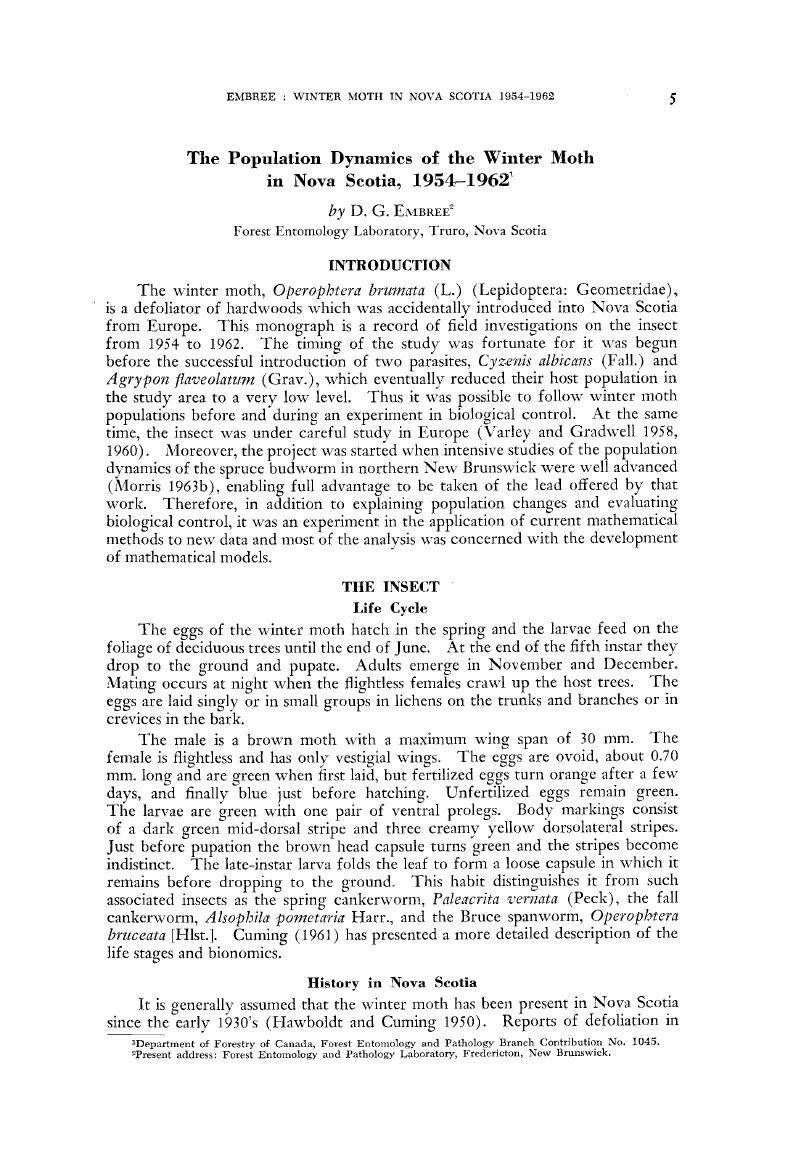Crossref Citations
This article has been cited by the following publications. This list is generated based on data provided by Crossref.
Feeny, P.P.
1968.
Effect of oak leaf tannins on larval growth of the winter moth Operophtera brumata.
Journal of Insect Physiology,
Vol. 14,
Issue. 6,
p.
805.
Itô, Yosiaki
and
Miyashita, Kazuyoshi
1968.
Biology of Hyphantria cuneaDrury (Lepidoptera: arctiidae) in Japan. V. Preliminary life tables and mortality data in urban areas.
Population Ecology,
Vol. 10,
Issue. 2,
p.
177.
Buckner, Charles H.
1969.
THE COMMON SHREW (SOREX ARANEUS) AS A PREDATOR OF THE WINTER MOTH (OPEROPHTERA BRUMATA) NEAR OXFORD, ENGLAND.
The Canadian Entomologist,
Vol. 101,
Issue. 4,
p.
370.
Harris, P.
Peschken, D.
and
Milroy, J.
1969.
THE STATUS OF BIOLOGICAL CONTROL OF THE WEED HYPERICUM PERFORATUM IN BRITISH COLUMBIA.
The Canadian Entomologist,
Vol. 101,
Issue. 1,
p.
1.
Beckwith, Roy C.
1970.
INFLUENCE OF HOST ON LARVAL SURVIVAL AND ADULT FECUNDITY OF
CHORISTONEURA CONFLICTANA (LEPIDOPTERA: TORTRICIDAE).
The Canadian Entomologist,
Vol. 102,
Issue. 11,
p.
1474.
Cheng, H. H.
and
LeRoux, E. J.
1970.
MAJOR FACTORS IN SURVIVAL OF THE IMMATURE STAGES OF FENUSA PUSILLA IN SOUTHWESTERN QUEBEC.
The Canadian Entomologist,
Vol. 102,
Issue. 8,
p.
995.
Peschken, D. P.
1972.
CHRYSOLINA QUADRIGEMINA (COLEOPTERA: CHRYSOMELIDAE) INTRODUCED FROM CALIFORNIA TO BRITISH COLUMBIA AGAINST THE WEED HYPERICUM PERFORATUM: COMPARISON OF BEHAVIOUR, PHYSIOLOGY, AND COLOUR IN ASSOCIATION WITH POST-COLONIZATION ADAPTATION.
The Canadian Entomologist,
Vol. 104,
Issue. 11,
p.
1689.
Mansingh, A.
1972.
Developmental response of Antheraea pernyi to seasonal changes in oak leaves from two localities.
Journal of Insect Physiology,
Vol. 18,
Issue. 7,
p.
1395.
Southwood, T.R.E.
1975.
Insects, Science & Society.
p.
151.
DeBach, Paul
Huffaker, C.B.
and
MacPhee, A.W.
1976.
Theory and Practice of Biological Control.
p.
255.
Mitter, Charles
Futuyma, Douglas J.
Schneider, John C.
and
Hare, J. Daniel
1979.
GENETIC VARIATION AND HOST PLANT RELATIONS IN A PARTHENOGENETIC MOTH.
Evolution,
Vol. 33,
Issue. 3,
p.
777.
Futuyma, Douglas J
Leipertz, Steven L
and
Mitter, Charles
1981.
Selective factors affecting clonal variation in the fall cankerworm Alsophila pometaria (Lepidoptera: geometridae).
Heredity,
Vol. 47,
Issue. 2,
p.
161.
McNamee, P. J.
McLeod, J. M.
and
Holling, C. S.
1981.
The structure and behavior of defoliating insect/forest systems.
Population Ecology,
Vol. 23,
Issue. 2,
p.
280.
Nakasuji, Fusao
1982.
Population dynamics of a migrant skipper butterfly Parnara guttata (Lepidoptera: Hesperiidae) II. Survival rates of immature stages in paddy fields.
Population Ecology,
Vol. 24,
Issue. 1,
p.
157.
DEMPSTER, J. P.
1983.
THE NATURAL CONTROL OF POPULATIONS OF BUTTERFLIES AND MOTHS.
Biological Reviews,
Vol. 58,
Issue. 3,
p.
461.
LATTIN, JOHN D.
and
OMAN, PAUL
1983.
Exotic Plant Pests and North American Agriculture.
p.
93.
HOLLIDAY, N. J.
1985.
Maintenance of the phenology of the winter moth (Lepidoptera: Geometridae).
Biological Journal of the Linnean Society,
Vol. 25,
Issue. 3,
p.
221.
Shiotsu, Yoshifumi
and
Tsubaki, Yoshitaka
1986.
One‐host one‐parasitoid system: Population dynamics of a zygaenid moth Pryeria sinica Moore in an undisturbed habitat.
Population Ecology,
Vol. 28,
Issue. 2,
p.
333.
Roland, Jens
Hannon, Susan J.
and
Angela Smith, M.
1986.
Foraging pattern of pine siskins and its influence on winter moth survival in an apple orchard.
Oecologia,
Vol. 69,
Issue. 1,
p.
47.
Leather, Simon R.
1986.
The effect of neonatal starvation on the growth, development and survival of larvae of the pine beauty moth, Panolis flammea (D & S).
Oecologia,
Vol. 71,
Issue. 1,
p.
90.



